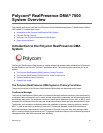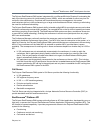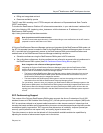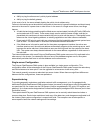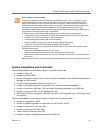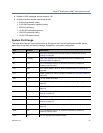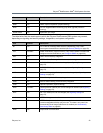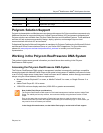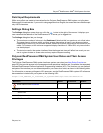
Polycom
®
RealPresence DMA
®
7000 System Overview
Polycom, Inc. 18
For multipoint conferencing, the MCU doesn't have to do processing-intensive mixing and transcoding to
optimize the experience for each device. Instead, it simply passes the video stream from each device to
each device, including the enhancement layers that provide the best quality the device can support.
Polycom’s SVC solution focuses on the temporal and spatial dimensions. It offers a number of advantages
over standard AVC conferencing, including:
● Improved video quality at lower bandwidths
● Improved audio and video error resiliency (good audio quality with more than 50% packet loss, good
video quality with more than 25% packet loss)
● Lower end-to-end latency (typically less than half that of AVC)
● More efficient use of bandwidth
● Lower infrastructure cost and operational expenses
● Easier to provision, control, and monitor
● Better security (end-to-end encryption)
Polycom’s SVC solution is supported by the Polycom RealPresence Platform and Environments, including
the latest generation of Polycom MCUs and RealPresence room, personal, desktop, and mobile endpoints.
Existing RMX MCUs with MPMx cards can be made SVC-capable with a software upgrade, and doing so
triples their HD multipoint conferencing capacity.
RealPresence Collaboration Server 800s MCUs support mixed-mode (SVC+AVC) conferences. Both SVC
and AVC endpoints can join the conference, and each gets the appropriate experience: SVC endpoints get
SVC mode and get a video stream for each AVC participant; AVC endpoints get a single Continuous
Presence (CP) video stream of the participants (both AVC and SVC) supplied by the MCU.
When the Polycom RealPresence DMA system selects an MCU that doesn’t support SVC for a conference
configured for mixed mode, it starts the conference as an AVC-only conference (all SVC-capable endpoints
also support AVC). But if the MCU supports SVC but not mixed mode (RMX 7.8), the conference fails to
start.
Refer to your RealPresence Collaboration Server or RMX documentation for important information about
the MCU’s implementation of SVC conferencing and its configuration, limitations, and constraints.
See also:
Introduction to the Polycom RealPresence DMA System on page 15
The Polycom RealPresence DMA System’s Three Configurations
Depending on your organization’s needs, you can deploy the Polycom RealPresence DMA system in one
of the following three configurations.
Two-server Cluster Configuration
The Polycom RealPresence DMA system is designed to be deployed as a pair of co-located redundant
servers that share the same virtual IP address(es). The two-server cluster configuration of the Polycom
RealPresence DMA system has no single point of failure within the system that could cause the service to
become unavailable.
The two servers communicate over the private network connecting them. To determine which one should
host the public virtual IP address, each server uses three criteria:
● Ability to ping its own public physical address








